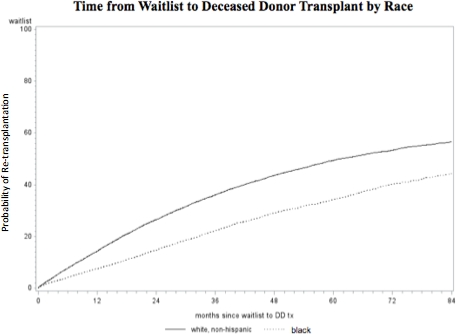Racial Disparities in Access to Kidney Re-Transplantation in the United States
Surgery, Emory Transplant Center, Atlanta, GA.
Meeting: 2015 American Transplant Congress
Abstract number: C29
Keywords: Kidney transplantation, Waiting lists
Session Information
Session Name: Poster Session C: Disparities in Healthcare Access
Session Type: Poster Session
Date: Monday, May 4, 2015
Session Time: 5:30pm-6:30pm
 Presentation Time: 5:30pm-6:30pm
Presentation Time: 5:30pm-6:30pm
Location: Exhibit Hall E
Introduction: The number of patients with a failed kidney transplant who are being considered for re-transplantation has steadily increased over the past few years. It is well known that disparities exist in access to the initial transplant and that race is an important consideration. The aim of this study was to investigate whether racial/ethnic disparities exist in access to kidney re-transplantation, and if so, to determine the factors that impact access to re-transplantation.
Methods: We used United States Renal Data System data to identify patients who had their first kidney transplant between 1995 and September 2011, and subsequently had a graft failure before September 30, 2011. Graft failure date was defined as return to dialysis after the initial transplant or receipt of another transplant. We examined key steps in access to re-transplantation, including access to waitlisting and receipt of a second transplant from either a deceased or a living donor using multivariable Cox proportional hazard models.
Results: Among the 43,853 patients included, 30.2% (6916) of whites and 17.5% (2794) of African Americans were transplanted over the study period; the mean age was 41.8 years. The median time from graft failure to re-transplantation was 27.4 months (IQR: 11.0-55.3 months); this varied by race: among blacks the median time was 35.1 months and among whites, 22.4 months.  We found that, overall, blacks had a 38% adjusted decrease in access to deceased donor re-transplantation (HR: 0.62; 95% CI: 0.59, 0.65). Even after adjusting for differences in demographic and clinical characteristics, including socioeconomic status (SES), blacks were still 30% (HR: 0.70; 95% CI: 0.66, 0.75) less likely to receive re-transplantation than whites. However, blacks only had a 5% decrease in access to the waitlist as compared to whites (HR: 0.95; 95% CI: 0.92, 0.98).
We found that, overall, blacks had a 38% adjusted decrease in access to deceased donor re-transplantation (HR: 0.62; 95% CI: 0.59, 0.65). Even after adjusting for differences in demographic and clinical characteristics, including socioeconomic status (SES), blacks were still 30% (HR: 0.70; 95% CI: 0.66, 0.75) less likely to receive re-transplantation than whites. However, blacks only had a 5% decrease in access to the waitlist as compared to whites (HR: 0.95; 95% CI: 0.92, 0.98).
Conclusion: Substantial racial disparities in access to re-transplantation exist even after accounting for SES. Access to the waitlist alone does not account for these differences. Further research is needed to determine the cause of disparity between blacks and whites in access to kidney re-transplantation after waitlisting.
To cite this abstract in AMA style:
Garrett C, Patzer R, Zhang R, Adams A. Racial Disparities in Access to Kidney Re-Transplantation in the United States [abstract]. Am J Transplant. 2015; 15 (suppl 3). https://atcmeetingabstracts.com/abstract/racial-disparities-in-access-to-kidney-re-transplantation-in-the-united-states/. Accessed January 7, 2026.« Back to 2015 American Transplant Congress
